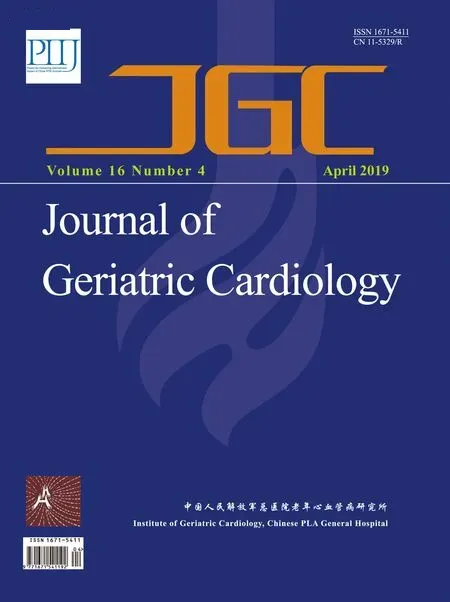Two cases of intercoronary communication between circumflex artery and right coronary artery
Xue-Dong GAN, Pei TU, Yao GONG, Wen-Hao SONG, Lin ZHANG, Hai-Rong WANG
Department of Cardiology, Zhongnan Hospital of Wuhan University, Wuhan, China
Keywords: Coronary angiography; Intercoronary communication
Intercoronary communication is an uncommon congenital coronary variation.[1]There is a connection between two or more coronary arteries whose blood flow can be either unidirectional or bidirectional.[2]Therefore, this anomalous intercoronary communications may be mistaken as a functional collateral vessel seen in the obstructive coronary artery disease (CAD). Coronary collateral vessels are usually related to severe coronary stenosis or total occlusions, while intercoronary communication is usually found in angiographically normal coronary arteries. Intercoronary communication differentiates coronary collateral vessels by angiographic features and histological structure.[3,4]The functional importance of intercoronary communication remains controversial.[1,3]We report two cases about this rare communication between left circumflex artery (LCx) and right coronary artery (RCA).
A 53 years old patient with a history of smoking and drug abuse complained of chest pain for 3 hours. The electrocardiogram showed a 1.0 mm horizontal ST segment depression and T-wave inversion in inferior leads. Echocardiography showed the left atrium was slightly larger, impaired left ventricular diastolic function, left ventricular ejection fraction is 59%. Laboratory findings showed elevated cardiac enzyme, the cardiac troponin I level was 3.565 ng/mL (0-0.028 ng/mL). These suggested that a coronary angiography was needed. Coronary angiography showed there is no stenosis in the coronary arteries. However, a slow of the right ventricular branch artery was seen, with thrombolysis in myocardial infarction (TIMI) grade 1 flow;after intracoronary injection of 200 μg of nitroglycerin, the blood flow was recovery with TIMI grade 3 flow. RCA angiography revealed filling of distal LCx (Figure 1), we suspected it was collateral vessel, so simultaneous left and right coronary angiography was carried out showing the connection between LCx and RCA was intercoronary communication (Figure 2). Selective left coronary angiogram shows LCx fill distal RCA (Figure 3). So patient was treated medically. After 30 months of follow-up, the patient had no symptoms.
Another patient is a 76 years old man admitted to hospital for chest tightness. He had a history of hypertension,radiofrequency ablation of atrial fibrillation, pacemaker implantation for sick sinus syndrome, and lacunar infarction.Electrocardiogram showed pacemaker rhythms, frequent premature ventricular contractions, extensive changes of ST-T. The cardiac enzyme was normal. Echocardiography showed mild calcification of the aortic valve and mild to moderate aortic regurgitation, biatrial enlargement, mild-tomoderate insufficiency of the mitral valve and severe tricuspid valve insufficiency, left ventricular ejection fraction is 60%. Coronary angiography was performed and showed:50% stenosis in ostium of left anterior descending artery(LAD), moderate calcification in proximal LAD, 50%stenosis in middle of LAD, 50% stenosis in first diagonal branch of LAD, diffuse stenosis in proximal LCx, 50%stenosis in distal of LCx, and 80% stenosis in proximal of RCA. Selective right coronary angiography showed blow flow retrograde filling of distal LCx from distal RCA (Figure 4), whereas, selective left coronary angiography didn't fill distal RCA (Figure 5). Considering the angiographic features, we thought the connection between LCx and RCA was intercoronary communication. So the patient was treated with medicine conservative treatment.

Figure 1. Selective RCA angiography showed retrograde filling of distal LCx from distal RCA. LCx: left circumflex artery;RCA: right coronary artery.

Figure 2. Simultaneous left and right coronary angiography showed intercoronary communication between LCx and RCA.LCx: left circumflex artery; RCA: right coronary artery.

Figure 3. Selective left coronary angiography showed LCx fills distal RCA. LCx: left circumflex artery; RCA: right coronary artery.

Figure 4. Selective right coronary angiography showed unidirectional flow retrograde filling of distal LCx from distal RCA. LCx: left circumflex artery; RCA: right coronary artery.

Figure 5. Selective left coronary angiogram revealed that distal RCA wasn’t showed. LCx: left circumflex artery; RCA:right coronary artery.
Intercoronary communication is uncommon congenital coronary variation.[5,6]It's estimated that coronary angiogram diagnosis of intercoronary communication incidence was 0.05%.[1,4]It is suggested that fetal coronary circulation is a potential mechanism of intercoronary communication.[4,6,7]This abnormality is a congenital anomaly and it should be distinguished from collateral vessels developed after CAD. They are distinguished from coronary collaterals by angiographic features and histological structure. In angiographic features, the collateral circulation is generally no more than 1 millimeter in diameter and is helical, whereas,intercoronary communication tend to be straight, larger (≥ 1 mm) in diameter, and extramural.[6,8]In histological structure, collateral vessels resemble arterioles which are supported by endothelia, lacking of collagen, muscle fibers and elastic fibers, while intercoronary communication is epicardial coronary vessel with integral muscle layers.[6-8]
We present two cases to learn more about intercoronary communication. In these two cases, we can acquire that it is important to know the normal anatomy of coronary artery and congenital anomaly for proper therapy.
Acknowledgments
This study was supported by grant from the National Natural Science Foundation of Hubei Province (No. 2017 CFB671). The authors had no conflicts of interest to disclose.
 Journal of Geriatric Cardiology2019年4期
Journal of Geriatric Cardiology2019年4期
- Journal of Geriatric Cardiology的其它文章
- Pacemaker lead induced cardiac perforation presenting with pneumothorax
- A rare case of non-ST-segment elevation myocardial infarction triggered by coronary subclavian steal syndrome
- Discrimination of ventricular tachycardia and localization of its exit site using surface electrocardiography
- Twenty-four-hour ambulatory blood pressure changes in older patients with essential hypertension receiving monotherapy or dual combination antihypertensive drug therapy
- The rate of patients at high risk for cardiovascular disease with an optimal low-density cholesterol level: a multicenter study from Thailand
- Long-term outcome of patients with atrial myxoma after surgical intervention:analysis of 403 cases
